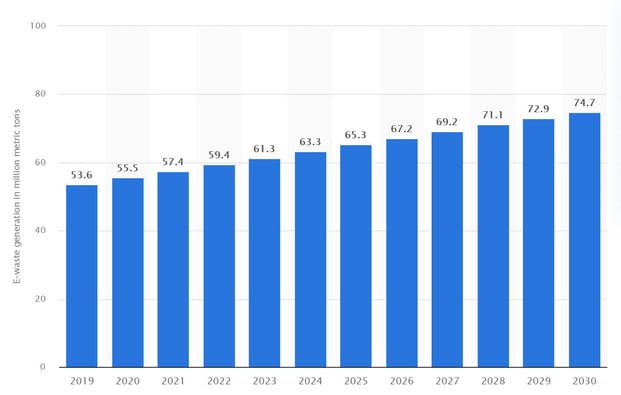
International E-Waste Day has been observed on October 14th every year since 2018. Apto Solutions is joining over 100 organizations from 78 countries around the globe to raise awareness on the importance of properly recycling electrical products. The focus of this year’s International E-Waste Day is on small electrical devices – like old cell phones that find their way into your family junk drawer or are often tossed in the garbage.
Each year millions of small electronic devices end up in landfills.
E-waste is a global problem that is growing in severity every year. This growth trend is expected to continue, with projections showing that by 2030, annual e-waste generation worldwide is likely to increase by approximately 30 percent. With this level of unrestrained growth, business as usual (i.e. a linear economy) is truly unsustainable!
In 2021, humans discarded approximately 63.3 million tons of e-waste. This amount outweighs the Great Wall of China - the world's heaviest human construction! In the US alone, around 151 million phones end up in landfills or incinerators every year (amounting to 416,000 a day) but less than 20% of e-waste is properly recycled.
Electronics are resource-intensive to make, and as the figures above demonstrate, a challenge to dispose of. Going by hard numbers, e-waste makes up less than 2 percent of the world’s waste, but it causes over 70 percent of harmful and toxic environmental effects! On top of that, humans have a habit of buying new technology every 2-3 years and consequently getting rid of not-so-old electronics.
In this context it’s important that consumers understand how their cell phones and tablets are made, where the materials come from, and the negative environmental effects that our ‘consumer culture’ is having on the world around us. This is why the focus of International E-Waste Day 2022 is focused on small electronic items, under the slogan ‘Recycle it all, no matter how small!’.
International E-Waste Day was developed by the WEEE Forum, an international association of e-waste collection organizations, and its members. The day is used as a platform to bring consumer’s attention to the importance of repairing or correctly disposing of their used electronics with the aim to increase re-use, recovery, and recycling rates.October 14th is the occasion to foster a stronger commitment among those involved in the electronic & electrical industry.
Understanding E-waste
“E-waste”, “electronic waste”, “e-scrap” and “end-of-life electronics'' are terms to describe used electronic products that are unwanted or not working and need to be discarded. The United States Environmental Protection Agency (EPA) considers e-waste to be a subset of used electronics and recognizes the value of these materials that can be reused, refurbished or recycled to minimize waste that could end up in a landfill or improperly disposed in an unprotected dump site - in the US or abroad.
Though many corporations are making changes to their manufacturing processes to reduce the amount of waste produced, it’s important that consumers understand their own contribution to the global e-waste problem and take actions to dispose of unwanted electronics properly.
E-waste that ends up in a landfill, whether in the US or in other countries, presents a serious threat to public health and can pollute ecosystems for generations to come. Improperly discarded e-waste contains toxic chemicals that are harmful to the soil, water, air, and wildlife, leaching from metals when buried in the ground. As toxic chemicals are released, they impact the earth’s air, soil, water, and ultimately, human health.
 Top hazardous materials found e-waste disposal.
Top hazardous materials found e-waste disposal.
Our team created this report to answer questions on how improperly disposed electronics impact the earth’s air, soil, water, and ultimately, human health. We found it’s not just the extreme volume of e-waste, it’s the toxicity!
Download the Report Now
The Do’s and Don’ts of proper e-waste disposal
The DO’S
- Follow product manual instructions for proper handling of end-of-life equipment
- Make sure electronic products are recycled by authorized recyclers/dismantlers
- Consult your nearest recycling facility for disposing of products that have reached the end of life
- Protect the glass surface of any electronic product to avoid breakage
- Don’t dismantle your electronic products yourself
- Don’t dispose of electronic products in bins having 'Do Not Dispose of' sign
- Never sell or give e-waste to informal and unorganized sectors like local scrap dealer or pickers
- Never throw your electronic waste along with municipal waste (this is how they end up in landfills!)